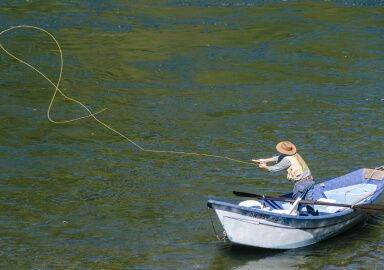Featherbacks
Shaped like knives and can swim backwards: featherbacks are a group of freshwater fish that are important for aquarium trade, and have spread far beyond their original range in Africa and Southeastern Asia due to their popularity as aquarium fish.
View 2 listings
2
listings
–
price starting from
2
countries
–
to the nearest trip
Where and When?
Featherbacks are found in parts of Africa and south-east Asia, but should not be confused with the electric knifefishes that are found in Central and South America. One featherback species, the reticulated featherback, Papyrocranus afer, is distributed in tropical West Africa in Ghana and Nigeria, while the remaining species are found in Laos, Cambodia, Myanmar and Vietnam.
The clown featherbacks are one of the most widespread invasive fish species, and one that has caused much concern. They are popular in the aquarium trade but often outgrow their tanks and are “liberated” into the wild, having thus found their way into many warm areas in Europe and North America. Parts of southern Florida, such as around Lake Ida, are now home to the clown featherback.
They live in fresh and sometimes brackish water, usually in still or slow-moving areas. Juveniles tend to be located in shallower waters, around weeds and logs, while adults also favour structure but in deeper water. All featherbacks are principally nocturnal but most will also occasionally move in daylight, particularly on overcast days and early and late in the day. They are tropical species, living in areas with relatively little temperature changes during the year. No large-scale migrations or aggregations are known.
About Featherbacks
Featherbacks are one of ten species of the Notopteridae family, the best-known species being the clown featherback, Chitala ornate, and the bronze featherback Notopterus notopterus. All species are similar-shaped, being very thin with a pronounced head, large mouth, indented forehead and a knife-like body. Colours vary, but are mostly silver-grey with some lateral stripes. The clown featherhead has up to ten large and obvious black centred “eye spots” along the lower rear of its flank.
The clown featherback, one of the largest species, can grow to over one metre (3.3 ft.) and an impressive five kilograms (11 lbs.) while the bronze species is smaller at about 80 cm. (31.5 in.) and two kilograms (4.4 lbs.) They are predators, feeding mostly on fish but will also take frogs and invertebrates. Featherbacks inhabit lakes, pans and slow-moving river and backwaters. Young tend to aggregate in shoals but, as they grow, they become loners and can take up territories. Featherbacks can survive in some low oxygen and even polluted waters by being able to supplement normal breathing by gulping in air from the surface.
How to Catch?
Within its natural distribution, featherbacks are popular as food, and have been caught in large numbers by many methods for hundreds of years, usually with nets and traps. Rod and line fishing is not usually a way to target featherbacks for food. However, there are now a few destinations, principally in Cambodia and Thailand, where sport fishing for featherbacks has been developed and offered to visiting anglers.
The clown featherback, due to its characteristic shape and eyespots, but also its ability to leap out of the water and move backwards rapidly, has become a favourite sport fishing target. While few sport anglers will travel to Asia to target featherbacks, the wild populations in southern Florida are attracting increasing numbers of American anglers.
Featherbacks will take live and dead bait as well as suitable lures. Typical bass fishing outfits, baits and lures work well, and the fish also often behave like bass. They can be strong fighters and the leaps can be wild and high, but it is their ability to shoot rapidly backwards, often out of landing nets, that can take anglers by surprise. Featherbacks, while being aliens and limited in distribution in the USA, are an interesting and exciting species to add to your life list of species caught.






